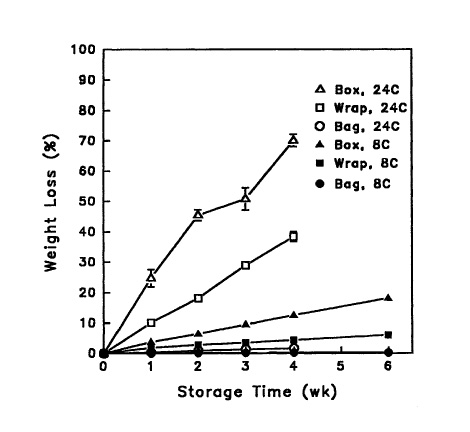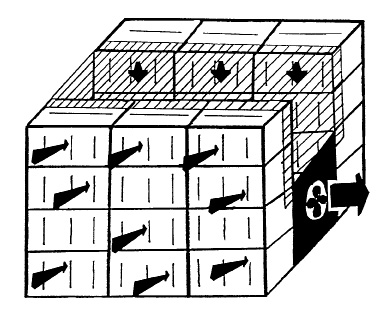Guide H-235
Revised by Stephanie Walker
College of Agricultural, Consumer and Environmental Sciences, New Mexico State University
Author: Extension Vegetable Specialist, Department of Extension Plant Sciences, New Mexico State University (Print Friendly PDF)
Fresh chiles are valued for their unique and varied flavors and pungency, attractive colors, and crisp texture. Chile fruits are also among the richest known plant sources of vitamin C. Fresh chiles are living tissues and are high in moisture content even after harvest. Once the fruit is removed from the plant, it is vulnerable to desiccation (drying), mechanical injury, and decay. The fruits continue to respire, produce ethylene, and change color as they ripen. Respiration is the process by which stored carbohydrates (sugars) are converted into simpler products to release energy; respiration involves oxygen (O2) uptake and carbon dioxide (CO2) production. Ethylene is the natural ripening hormone present in fruits. These physiological changes generally lead to quality loss and limited shelf life for chiles because stored reserves are used and salable dry weight declines. Additionally, ethylene causes fruit softening, over-ripening, and a predisposition to decay.
All chiles can be used fresh; however, most chile types consumed fresh have a thick wall, such as bell, New Mexican type green chile, jalapeño, and pimiento. Whether the chiles are intended for fresh market or for processing, a chain of quality must be maintained from field production to consumption for maximum shelf life. High-quality chile begins with selecting the proper variety and purchasing certified seed. Good cultural practices such as fertilization, irrigation, and disease management in the field are critical to producing a high-quality crop. The level of stress that the crop endures in the field will influence yield, pungency, fruit color, diseases, and, ultimately, postharvest quality.
Quality Criteria And Maturity Indices
A chile crop should be inspected throughout the growing season to estimate whether the crop's yield and quality will meet market standards. However, several quality criteria can be assessed postharvest, including maturity, freshness, and freedom from diseases, mechanical injuries, insects, blossom-end rot, sunscald, and freeze injury. In general, chiles harvested late in the season will have inferior quality, and therefore a shorter shelf life, than early or midseason harvests. Fruit firmness or degree of dehydration is the primary indicator of chile freshness. Fresh green chile loses water very quickly after harvest and begins to shrivel and turn color within a few days if not refrigerated. Chile stems should be firm and green; darkening, shriveling, or rotting of stems indicates that the chile was not harvested recently.
Select chiles with the desired maturity for the intended market. Maturity is generally judged according to physical traits such as size, shape, color, and texture. Most mature green chiles should be firm and dark green in color. This includes bell, New Mexican, and jalapeño types. Chile fruits should not be turning orange or red unless they will be marketed red, as with pimientos and some bells. If the chiles are light green and yield easily to pressure when squeezed, they are immature. An ideal New Mexican long green chile is firm, smooth, thick-fleshed, and bluntly pointed. Green chile for canning should be flat with two locules and about 6 in. (15 cm) long. Bell types should be large, firm, crisp, and blocky, with four lobes. Jalapeños should be thick-walled, conical, glossy green, and about 2.75 in. (7 cm) long and 1 in. (3 cm) wide. Pimientos are typically processed, but are delicious when eaten fresh. They should be fully mature, heart-shaped, bright red, thick-walled, and firm. Other chiles that may be used fresh, but that are commonly brined, include the cherry, serrano, and wax types.
Harvest And Handling
During harvest and handling, it is important to remember that chile fruits soften easily and develop postharvest diseases if they are damaged, bruised, or subjected to sustained high temperatures. All chile types, especially New Mexican green chiles, are highly susceptible to water loss, sunscald, and heat damage. These problems are likely to occur if chiles are allowed to sit for more than an hour in direct sunlight. Fresh chile harvested in the summertime can have pulp temperatures of 90°F (32°C) or more. For these reasons, chiles should be harvested in the early morning, placed in the shade, and cooled as soon as possible. If the chiles are not cooled within 1 to 2 hours, they will begin to show signs of water loss and softening.
Most fresh chile is harvested by hand into buckets or sacks and then emptied into bulk bins for transport to the packing shed or processor. A field of long green chiles can be harvested in early August and then again in September. A third harvest will typically yield small fruits and may not be profitable.
Once at the shed, the chile is either dry-dumped onto padded ramps or moving conveyor belts, or wet-dumped into a chlorinated wash tank. Wash tanks should be cleaned daily, and the chlorination levels should be monitored frequently. These sanitation practices are necessary because chiles are highly susceptible to bacterial diseases that could be introduced through the wash tanks. Fruits are then sorted to remove diseased, overripe, immature, or otherwise defective pods. Grading according to USDA or other market standards can be done after sorting.
Fresh chile is typically packed in 1 1/4 bushel size corrugated cartons that hold 30 lb. Another package type is the 2-piece telescope style, with a lid that fits over the body. The boxes may be waxed, and should have top and bottom gaps and side slots for ventilation and cooling. Cartons should be sufficiently strong to endure stacking and shipping. Boxes should be stacked in a 3 × 2 cross-stack pattern, 6 high on a 40 × 48-in. pallet.
Packages with plastic (polyethylene) liners or bags have an additional barrier to fruit moisture loss. Plastic films reduce water loss from the chiles, but may interfere with cooling efficiency. Small perforations in the plastic will compensate for the barrier by improving gas exchange and increasing the airflow during cooling and storage. Chiles can also be packaged in small consumer units for retail markets using plastic bags or trays wrapped with films. These retail packages can be prepared at the packing shed or, more commonly, at the distribution center.
Both storage temperature and package container influence chile fruit weight loss (Figure 1). Chiles stored in boxes have a daily weight loss of about 3.5% at 75°F (24°C), but only 0.5% at 46°F (8°C). The use of plastic-wrapped trays or polyethylene bags decreases fruit weight loss further, especially at lower storage temperatures.
Figure 1. Percent weight loss of New Mexican long green chile stored at either 75°F (24°C) or 46°F (8°C) and packaged in boxes, wrapped trays, or polyethylene bags. During the first week of storage, boxed fruit had a daily weight loss of 3.5% at 75°F and 0.5% at 46°F.
Cooling And Storage
Fresh chile is a highly perishable commodity. Proper cooling extends the shelf life by slowing respiration, water loss, color change, and decay. Temperatures higher than 70°F (21°C) greatly accelerate ripening through respiration and ethylene production. Preferred cooling methods for chiles are room cooling and forced-air cooling. Cooling and storage are independent operations and the specific requirements for rapid cooling should therefore be considered separately from cold storage needs.
Room cooling exposes fresh produce to cold air in a refrigerated space. Bins or boxes must be stacked properly to permit airflow between the individual storage units. Room coolers can be partitioned into sections so that recently harvested chiles with high field heat are kept separate from previously cooled produce. Powerful fans and ceiling jets can be used to increase the airflow and, consequently, the cooling efficiency of room coolers.
Forced-air cooling is an active cooling process and is much faster at removing field heat than room cooling. With forced-air cooling, fans pull cool air through the boxes or bins of produce. Room coolers can be modified into forced-air coolers relatively quickly and inexpensively by adding extra fans and partitions.
There are several variations of forced-air cooling designs; the most common is the forced-air tunnel design (Figure 2). In this system, a row of bins or palletized boxes is placed on either side of an exhaust fan, creating an aisle between the two rows. The aisle and open end are covered with canvas to form a tunnel. The exhaust fan creates negative pressure in the tunnel and pulls cold air through the stacks to cool the produce. Containers must be adequately vented for proper airflow during forced-air cooling.
Figure 2. Diagram of a forced-air cooling tunnel design.
Forced-air evaporative cooling is a system that uses evaporative coolers instead of refrigeration units. This cooling system is practical in New Mexico because of our arid climate. An evaporative cooler is more energy-efficient than mechanical refrigeration, and growers can build their own systems. Forced-air evaporative coolers can lower the product temperature to about 60°F (16°C) and are most useful for chilling sensitive commodities (such as chiles) intended for a local market.
The optimum storage conditions for fresh chiles are 45 to 50°F (7-10°C) and 90 to 95% relative humidity. Chilling injury occurs at lower temperatures. The symptoms of chilling injury are softening, pitting, and an increased susceptibility to decay. Freeze damage occurs at 32°F (0°C). Most fresh chiles can be stored for 2 to 3 weeks if kept cool at the proper temperature. Chiles should be shipped on refrigerated trucks, but these vehicles should not be used for pre-cooling because refrigerated trailers do not have adequate cooling capacity or ventilation to remove field heat quickly. Transit cooling is intended only to keep previously cooled produce cold during shipping.
Poor temperature management and ethylene accumulation during storage or transit promote ripening and decay. Some fruits and vegetables produce much larger quantities of ethylene than chiles. For that reason, chiles should never be stored or shipped with crops such as tomatoes, apples, or melons. Storage rooms should be ventilated properly to reduce the accumulation of ethylene in the environment. Placing ethylene scrubbers containing potassium permanganate in the storage room or transit vehicle can also decrease ethylene levels.
Maintaining a chain of quality from grower through consumer is essential when handling fresh chiles. The basis of the chain of quality is proper cooling, but minimizing mechanical injuries, diseases, and ethylene exposure are also critical for maximum chile quality.
Original author: Marisa M. Wall, former assistant professor of horticulture.
To find more resources for your business, home, or family, visit the College of Agricultural, Consumer and Environmental Sciences on the World Wide Web at pubs.nmsu.edu.
Contents of publications may be freely reproduced, with an appropriate citation, for educational purposes. All other rights reserved. For permission to use publications for other purposes, contact pubs@nmsu.edu or the authors listed on the publication.
New Mexico State University is an equal opportunity/affirmative action employer and educator. NMSU and the U.S. Department of Agriculture cooperating.
Revised and electronically distributed in November, 2010 in Las Cruces, NM




